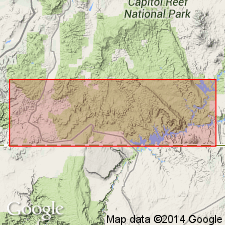
- Usage in publication:
-
- Co-op Creek Limestone Member
- Modifications:
-
- Named
- Dominant lithology:
-
- Limestone
- Shale
- Siltstone
- AAPG geologic province:
-
- Plateau sedimentary province
Summary:
Is named as basal member of Carmel Formation in western Kane Co, UT (Plateau sedimentary province). Is same as limestone member of Cashion (1967) and Kolob Limestone Member of Thompson and Stokes (1970). Renamed because, "the name 'Kolob' was previously proposed for an igneous unit (Kolob Latite) in Iron County by Averitt (1962)." Named from Co-op Creek in western Kane Co. Type section measured at Meadow Creek (The Barracks quadrangle) in NW1/4 SW1/4 sec 18, T41S, R8W, Kane Co. Overlies Temple Cap Sandstone (Middle Jurassic) at type section; overlain by Crystal Creek Member of Carmel. Lower contact sharp, unconformable; upper contact sharp, probably conformable. Is about 250 ft thick at type and consists mostly of limestone and shaly limestone; twelve units differentiated in type section; general section (ascending)--about 10 ft of bright reddish-brown siltstone, about 35 ft of blocky and ledgy limestone, 170 ft of shaly limestone, and 35 ft of alternating ledgy and slope-forming limestone. Thins eastward with Crystal Creek Member and combines to form Judd Hollow Tongue of the Carmel. Age is Middle Jurassic based on fossils following Imlay (1964).
Source: GNU records (USGS DDS-6; Denver GNULEX).
For more information, please contact Nancy Stamm, Geologic Names Committee Secretary.
Asterisk (*) indicates published by U.S. Geological Survey authors.
"No current usage" (†) implies that a name has been abandoned or has fallen into disuse. Former usage and, if known, replacement name given in parentheses ( ).
Slash (/) indicates name conflicts with nomenclatural guidelines (CSN, 1933; ACSN, 1961, 1970; NACSN, 1983, 2005, 2021). May be explained within brackets ([ ]).

